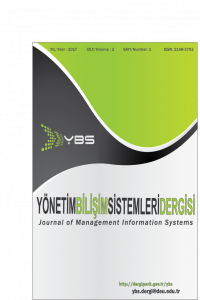Öz
Endüstri 4.0 son yıllarda gelişen teknoloji ve
toplumsal beklentiler ile yeni oluşturulan bir değer olduğu kabul edilmektedir.
Kıtalardan bağımsız üretim yapmayı hedefleyen işletmelerde tercih edilecek
yöntem olarak görünen Endüstri 4.0 imalatta yeni yaklaşımları da beraberinde
getirmektedir. Klasik anlamın dışında veri işleme ve aktarımı Endüstri 4.0 ile
farklı bir boyuta taşınmaktadır. Bu çalışmada Endüstri 4.0 ve Kurumsal Kaynak
Planlama (KKP) ile ilgili genel bilgiler verilmiş ve birlikte uygulanması
sırasında yapısal bir çatı (Framework) önerilmiştir. Önerilen yapısal çatı (Framework)
sistemin Endüstri 4.0 işleyişine katkısı ve gelecekteki önemi vurgulanmıştır
Anahtar Kelimeler
Endüstri 4.0 Kurumsal Kaynak Planlama Yönetim Bilişim Sistemi
Kaynakça
- Alçın, S., (2016), “Üretim İçin Yeni Bir İzlek: Sanayi 4.0”, Journal of Life Economics, sayı 8, s: 19-30, 2016. Doi: http://dx.doi.org/10.15637/jlecon.129
- Ashton, K. (2009). That ‘‘Internet of Things’’ thing, RFID Journal.
- Ayhan, K. (2013). Bilgi ve Belgenin Yönetimi. Gülseçen. S (Editör). Bilgi Yönetim Sistemleri: içinde s51-68. İstanbul: Papatya Yayınları.
- Cicibaş, H., Demir, K., A. (2016). Integrating Internet of Things (IoT) into Enterprises: Socio-technical Issuse and Guidelines. Yönetim Bilişimleri Sistemleri Dergisi. 1(3): 105-117.
- Erdil, A. Başlıgil, H. (2011), “Kurumsal Kaynak Planlamanın Endüstriyel İşletme Bünyesinde Kurulması, Kurulumunda Karşılaşılan Sorunlar ve Çözümleri”,Yıldız Teknik Üniversitesi, Mühendislik ve Fen Bilimleri Dergisi Sigma 29, s.196-230.
- Gartner Report (2012). “Gartner Survey Reports ERP software Spending at $24.9Bilion” http://www.erpsoftwareblog.com/2012/07/gartner-survey-reports-erp-software-spending-at-24-9-billion/, (erişim tarihi 23.05.2017).
- Groover, M., P., (2016) , Otomasyon, Üretim Sistemleri ve Bilgisayar ile Bütünleşik İmalat, Çev. Ed: Mustafa Yurdakul, Yusuf Tansel İç. Pearson.
- Gubbi, J., Buyya, R., Marusic, S., Palaniswami, (2013). M. Internet of Things (IoT): A vision, architectural elements, and future directions. Future Generation Computer Systems. 29, s. 1645-1660.
- Haller, S., Karnouskos, S., & Schroth, C. (2009). The Internet of Things in an Enterprise Context, Future Internet FIS 2008: First Future Internet Symposium, 29-30 September 2008, Vienna, Austria.
- Lee, I., & Lee, K. (2015). The Internet of Things (IoT): Applications, investments, and challenges for enterprises. Business Horizons, 58(4), 431-440.
- Liao. Y., Deschamps, F., Loures, E. deF. R., Ramos, F.P., (2017) Past, present and future of Industry 4.0 - a systematic literature review and research agenda proposal, International Journal of Production Research, 55:12, 3609-3629, DOI: 10.1080/00207543.2017.1308576
- McGinnis, T.C., Huang, Z. (2007). “Rethinking ERP success: A new perspective from knowledge management and continuous improvement”, Information & Management, Vol. 44, No 7, s. 626.
- Swanson, Z., Hepner, M. (2011). Knowledge Management ERP Curriculum Design/Mapping (Theory and Development Tools). Decision Sciences Journal of Innovative Education. (9) 2, s. 213-219.
- Vollman, T. E., Berry, W. L., Whybark, D. C., & Jacobs, F. R. (2005). Manufacturing Planning and Control for supply Chain Management (5th ed.). New York: McGraw-Hill.
- Woo, H.S. (2007). Critical success factors for implementing ERP: the case of a Chinese electronics manufacturer, Journal of Manufacturing Technology Management, Vol. 18 No. 4, s:431-442.
Öz
Kaynakça
- Alçın, S., (2016), “Üretim İçin Yeni Bir İzlek: Sanayi 4.0”, Journal of Life Economics, sayı 8, s: 19-30, 2016. Doi: http://dx.doi.org/10.15637/jlecon.129
- Ashton, K. (2009). That ‘‘Internet of Things’’ thing, RFID Journal.
- Ayhan, K. (2013). Bilgi ve Belgenin Yönetimi. Gülseçen. S (Editör). Bilgi Yönetim Sistemleri: içinde s51-68. İstanbul: Papatya Yayınları.
- Cicibaş, H., Demir, K., A. (2016). Integrating Internet of Things (IoT) into Enterprises: Socio-technical Issuse and Guidelines. Yönetim Bilişimleri Sistemleri Dergisi. 1(3): 105-117.
- Erdil, A. Başlıgil, H. (2011), “Kurumsal Kaynak Planlamanın Endüstriyel İşletme Bünyesinde Kurulması, Kurulumunda Karşılaşılan Sorunlar ve Çözümleri”,Yıldız Teknik Üniversitesi, Mühendislik ve Fen Bilimleri Dergisi Sigma 29, s.196-230.
- Gartner Report (2012). “Gartner Survey Reports ERP software Spending at $24.9Bilion” http://www.erpsoftwareblog.com/2012/07/gartner-survey-reports-erp-software-spending-at-24-9-billion/, (erişim tarihi 23.05.2017).
- Groover, M., P., (2016) , Otomasyon, Üretim Sistemleri ve Bilgisayar ile Bütünleşik İmalat, Çev. Ed: Mustafa Yurdakul, Yusuf Tansel İç. Pearson.
- Gubbi, J., Buyya, R., Marusic, S., Palaniswami, (2013). M. Internet of Things (IoT): A vision, architectural elements, and future directions. Future Generation Computer Systems. 29, s. 1645-1660.
- Haller, S., Karnouskos, S., & Schroth, C. (2009). The Internet of Things in an Enterprise Context, Future Internet FIS 2008: First Future Internet Symposium, 29-30 September 2008, Vienna, Austria.
- Lee, I., & Lee, K. (2015). The Internet of Things (IoT): Applications, investments, and challenges for enterprises. Business Horizons, 58(4), 431-440.
- Liao. Y., Deschamps, F., Loures, E. deF. R., Ramos, F.P., (2017) Past, present and future of Industry 4.0 - a systematic literature review and research agenda proposal, International Journal of Production Research, 55:12, 3609-3629, DOI: 10.1080/00207543.2017.1308576
- McGinnis, T.C., Huang, Z. (2007). “Rethinking ERP success: A new perspective from knowledge management and continuous improvement”, Information & Management, Vol. 44, No 7, s. 626.
- Swanson, Z., Hepner, M. (2011). Knowledge Management ERP Curriculum Design/Mapping (Theory and Development Tools). Decision Sciences Journal of Innovative Education. (9) 2, s. 213-219.
- Vollman, T. E., Berry, W. L., Whybark, D. C., & Jacobs, F. R. (2005). Manufacturing Planning and Control for supply Chain Management (5th ed.). New York: McGraw-Hill.
- Woo, H.S. (2007). Critical success factors for implementing ERP: the case of a Chinese electronics manufacturer, Journal of Manufacturing Technology Management, Vol. 18 No. 4, s:431-442.
Ayrıntılar
| Bölüm | Makaleler |
|---|---|
| Yazarlar | |
| Yayımlanma Tarihi | 1 Ağustos 2017 |
| Yayımlandığı Sayı | Yıl 2017 Cilt: 3 Sayı: 1 |


